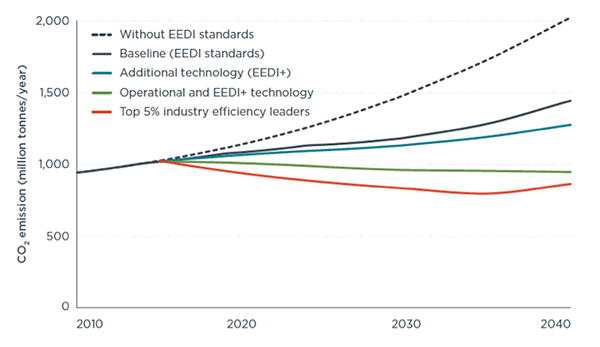Arctic sea shipping: Emissions matter more than you might think
Blog
Another tale of two cities
The Conference of Parties (COP19) in Warsaw last November saw at best modest progress toward a global pact on curbing greenhouse gas (GHG) emissions. Countries have until the first quarter of 2015 to publish their national GHG reduction plans, setting the cornerstone to a hoped-for global agreement in Paris in late 2015.
Gazing that far ahead toward Paris, though, may mean overlooking progress across the Channel in London, where the International Maritime Organization (IMO), the UN agency governing international shipping, is located. Between now and late 2015, London will host three Marine Environmental Protection Committee (MEPC) meetings, at each of which controlling GHGs from international shipping will be a central agenda item. In fact, international negotiations have been going on in London for the past decade over policy prescriptions of reducing GHGs from shipping, which represents 3.3% of the global GHG inventory.
The IMO has taken important steps to reduce GHG emissions in the past few years. In July 2011, it adopted the Energy Efficiency Design Index (EEDI), a regulation requiring new ships to achieve 10% to 30% energy-efficiency gains between 2015 and 2025, which we estimate would level off at about 250 million metric tonnes (MMT) of CO2 by 2030. More recently, discussions have focused on approaches to raising energy efficiency of the in-use fleet. A ship’s lifetime can be as long as 30 years, meaning that many vessels constructed before the EEDI will still be plying the world’s oceans for decades to come. Increasing the efficiency of in-use ships via incremental energy savings from improved maintenance or operational practices and new technologies, many of which were developed in the oil crisis in the 1970s but then shelved as oil prices declined in the 1990s, could achieve substantial carbon reductions. Slow steaming, to cite only one of numerous examples, has the potential to halve shipping emissions. And larger vessels, made more feasible by the expansion of the Panama Cannel, offer additional energy savings.
We estimate that if all ships harnessed these opportunities, so that the fleet as a whole was as efficient in 2040 as the most efficient 5% of ships in 2011, the shipping industry would keep its annual CO2 emissions 400 million metric tonnes below the level projected based on current trajectory (see the red line of the chart below). To put this differently, using only technologies and techniques available right now, the shipping industry could keep its carbon footprint for 2040 at the 2007 level while moving twice as many goods.

Figure 1 CO2 emissions from international shipping under various scenarios
Increasing the efficiency of the in-use fleet is an important step toward lessening the carbon footprint not only of shipping but of all transportation modes, including passenger vehicles and trucks. But establishing a mandatory standard for in-use shipping is particularly challenging. With the exception of containerships and cruise ships, shipping companies usually deploy a ship on different routes from year to year, making it difficult to benchmark the energy consumption of individual ships. The energy efficiency of shipping is sensitive to weather, wind, and current, which are difficult to model and predict. And the utilization rate of ships, a key indicator of ship efficiency in terms of GHG emissions per unit of cargo carried, varies according to the state of the global economy. To address these challenges, policymakers have focused on collecting better data on fuel usage and identifying appropriate metrics to reflect the complexity of ship operations.
The European Commission is contemplating a plan that would require ships using EU ports to monitor, report, and verify (MRV) their GHG emissions. The goal-based, non-prescriptive proposal would provide a lens through which policy makers, and even many ship owners themselves, could for the first time look closely at how ships consume fuel. Similarly, the French government has mandated that shipping companies serving French ports disclose their CO2 emissions of each service starting from October 2013. On the other side of the Atlantic, since 2012 the US has been refining an IMO proposal to formulate metrics that properly represent ship operational efficiency while taking into consideration differences in contractual structures, weather conditions, and load factors. Sensing that in-use efficiency regulation is on the horizon, influential industry lobby groups have publicly endorsed MRV and data collection in the IMO, setting the stage for a greater effort toward curbing CO2 emissions from shipping.
By the time Paris opens her doors to a flood of participants with mixed feelings or great expectations for the COP20 in 2015, country delegates in London may have already agreed upon the framework of data collection and be well on the way to an in-use efficiency standard to boot. Who knows? The example of such an agreement in London would certainly add momentum to the pursuit a much broader agreement in Paris to succeed the expired Kyoto Protocol, opening a new chapter in the tale of those two great cities.
